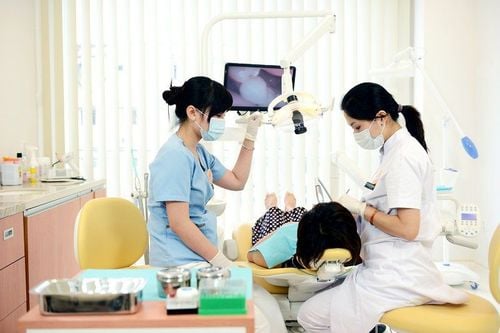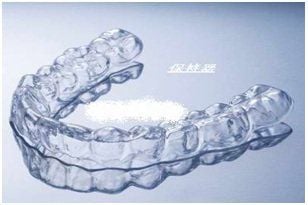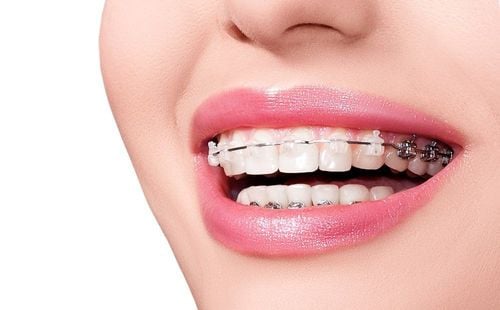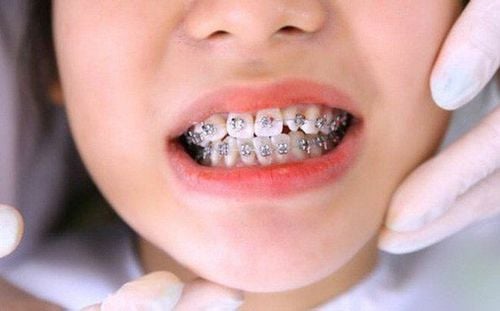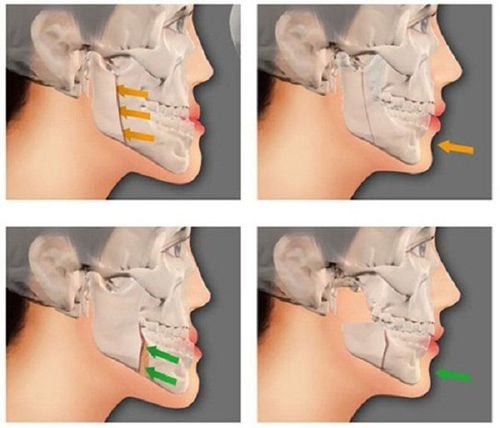This is an automatically translated article.
Most people don't care about their jaw joint, also known as TMJ (temporomandibular joint), until something goes wrong leading to a misaligned jaw. Jaw alignment problems can cause serious painful side effects such as headaches and ringing in the ears. So what is the cause and how to correct the deviation function? Continue reading to learn more about this misalignment.
1. Jaw deviation: Causes and symptoms
A misaligned jaw can contribute to problems with eating, sleeping, speaking and breathing. There are many causes of uneven jawline. Some cases can be treated and improved with physical therapy. Other cases may require surgical repair.
Cause Doctors call the lower part of the jaw the stoma. It is separate from the rest of the skull. The lower jaw connects to the skull, and then through the temporomandibular joints (TMJs), allowing the jaw to open and close.
Jaw function requires tendons, bones and muscles to work together. An imbalance in any of these structures can lead to the entire function becoming uneven.
Here are some reasons why the jaw is misaligned:
Trauma or broken jaw
Injuries can happen from an accident, fall, assault or sports-related injury. Trauma can cause your jaw to break, crack, or misalign.
Mild fractures will usually heal on their own. A large fracture in the jaw may require surgery to help the jawbone heal normally. A misaligned jaw may require surgery to stabilize.
When the mandible is fractured or broken, trauma can lead to a complete fracture with displacement of the bone or a fracture without movement of the bone.
Jaw dislocation usually occurs when the mandible becomes detached from one or both TMJs.
The upper jaw or the upper part of the jaw may be broken. However, doctors will treat these injuries as facial fractures rather than jaw fractures.
Trauma to the face is also likely to lead to a fracture or misalignment of the jaw. The occurrence of these two injuries will depend on the location of the injury and the degree of force. Injuries can be caused by many different things such as falls or sports injuries.
Opening your mouth too wide is a common cause of a misaligned jaw. This can happen through:
Yawning Biting Vomiting A dental procedure
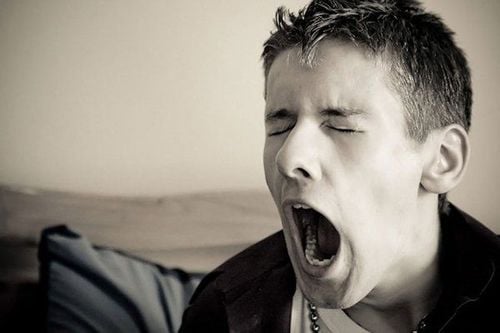
Há miệng quá rộng có thể khiến bạn gặp tình trạng hàm lệch
TMJ disorder
Temporomandibular joint (TMJ) disorder is very common. Trauma or arthritis can be the cause of TMJ. However, sometimes symptoms can occur without an obvious cause.
Temporomandibular joint disorders cause pain and affect the movement of the jaw. People with these disorders have a higher risk of dislocated jaws. People who have had a misaligned jaw in the past are also at a higher risk of having a misaligned jaw.
You can treat TMJ disorder by doing the following:
Apply ice to the jaw to relieve pain and inflammation. Take an over-the-counter pain reliever, such as acetaminophen (Tylenol) or ibuprofen (Advil). Avoid strenuous jaw movements. Wear orthodontic appliances to lift the bite and reposition the jaw. Practice temporomandibular joint exercises to relieve pain and improve jaw movement. Managing and reducing stress will help relax your jaw. Birth defects
You may have been born with a certain jaw condition. For example, you might have a function that is naturally crooked. This is also known as a “faulty function”. A faulty jaw can be repaired with surgery or can be managed with supportive care and lifestyle changes.
Align teeth
Irregular jaws can be caused by misaligned teeth. Your teeth probably won't allow your jawbone to stay in place. Braces or retainers can help correct this. It may take 6 - 18 months for results to show. In severe cases, it can take longer.
Symptoms Symptoms of a misaligned jaw include:
Pain in the face or jaw, in front of the ear or on the affected side, that gets worse with movement The lower part of the jaw is out of alignment with the lower part of the jaw. upper Stiffness and difficulty moving the jaw Unable to close the mouth Biting that feels "skewed" or crooked Problems talking Drooling from not being able to close the mouth Jaws locked or protruding forward Teeth out of alignment
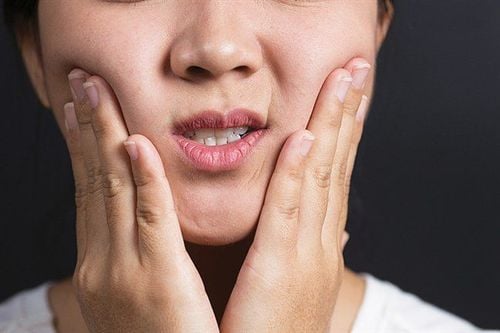
Hàm lệch khiến người bệnh thấy cứng và khó cử động hàm
2. What does the bias function look like?
Many people get orthodontic treatment to correct their crooked teeth, but braces can also solve bite problems. Braces are a great way to correct misaligned jaws in children and adults, and help prevent the consequences of protrusion and protrusion. A misaligned jaw is often painful and obvious, and many children unfortunately get teased about it by their peers. Our "bite" refers to the upper and lower teeth that meet, affecting the way we chew, eat, and speak. The two most common bite problems are an underbite and an overbite, with underbite occurring whenever the lower jaw is in front of the upper jaw while overbite occurs when the upper jaw protrudes abnormally relative to the lower jaw. While these deformities may look awkward, they have more serious consequences than cosmetic concerns. The lower jaw creates a bulldog-like appearance as the lower jaw protrudes, which not only puts a lot of pressure on the joint but also wears down the teeth. Excessively crooked teeth create protruding bucket teeth that can break easily and make it difficult to close the mouth and lips. They also create an elongated face, speech problems, and an increased chance of tooth decay as oral tissue dries out. Depending on the severity of the misalignment and what bite is involved, treatment options such as braces, cosmetic dentistry, and surgery are common ways to correct the problem.
3. How to correct the deviation function
Many orthodontic patients experience misaligned, misaligned jaws that affect the way teeth rest in the mouth and cause bite problems. Excessive, where the upper teeth protrude and the lower teeth, when the lower teeth grow farther out than the upper teeth, can cause physical and emotional discomfort. If left untreated, a misaligned jaw can affect the way you eat, speak, and sleep. Fortunately, there are many types of orthodontic treatments and devices that can be used to correct misalignment and restore your confidence.
For crooked or crowded teeth and misaligned jaws, braces are the standard treatment performed for most patients. Traditional braces, with brackets that are firmly attached to the teeth and attached to an arch, remove excess teeth to straighten the upper front teeth and return them to a position that does not protrude. For extreme cases of excess and deficiency, a helmet brace may be necessary. These devices are made with internal and external straps, along with straps that fit over the head and neck, to move the upper jaw forward or backward. Hooded braces are usually worn for 12-14 hours a day, but are only needed when traditional braces cannot correct the misalignment. For the lower jaw, maxillary extender: It is recommended to widen the palate so that the lower teeth move back to their original position. The expander is placed on the upper palate and opens each night with a special key, and after a year the palate should be wide enough for both the upper and lower jaw to fit together. For the most severe cases of jaw misalignment, surgery will be required. Plates, screws, and wires are surgically placed into the jaw by an orthodontist to permanently correct bite problems, significantly improving speech and sleep.
Irregular jaw surgery
Repositioning your jaw will sometimes require surgery. The type of surgery chosen will depend on the underlying cause of your irregular jaw. Your doctor may choose to:
Maxillary osteotomy: This is a surgery performed in the upper jaw to correct an open or crossbite bite. The upper jaw and teeth are moved forward so that they are aligned with the teeth and lower jawbone. Mandibular osteotomy: This surgery corrects problems such as a misaligned and protruding lower jaw. Your surgeon makes cuts in the back of your mouth to move the lower jaw forward or backward. Gene shaping: bone plastic surgery will correct the condition of a small or misaligned chin. Jaw and chin contouring surgery by cutting the chin bone in front of the jaw angle. Jawline system: The bowstring is used to fix the jaw to a certain position or provide support in the event of fractures and breaks.
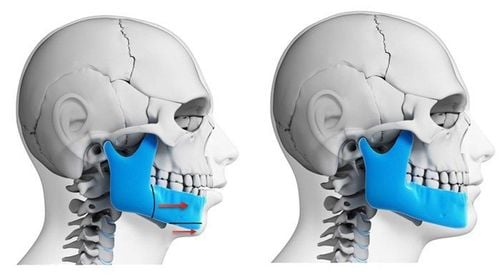
Phương pháp cắt xương hàm dưới chỉnh hàm lệch
4. The importance of orthodontic examination
Although many occlusal problems are obvious, some are so mild that they are difficult to detect. In these cases, it is important for children and adults to have regular orthodontic visits so that tooth movement and growth can be monitored. An orthodontic visit, especially in young children, is essential to observe teeth that are about to come in, reduce the risk of tooth impact, monitor jaw bone growth, and detect potential dental problems. hidden. Not only will your teeth be examined, but your jaw and mouth will also be checked for signs of underlying disease, decay and disease, and cleaned thoroughly. These visits also provide patients with the information they need to form good dental habits early to keep their teeth healthy and free of decay both during and after orthodontic treatment.
Dental - Jaw - Facial - Vinmec International General Hospital specializes in examining and treating all common dental problems in adults and children. The hospital has a team of qualified doctors and dentists and a system of advanced machinery to help support the examination process well and shorten the time.
Therefore, when there is any problem, you can go to the hospital to be checked for appropriate instructions from a specialist doctor. Avoiding leaving for a long time will affect the structure and aesthetics of the teeth.
Please dial HOTLINE for more information or register for an appointment HERE. Download MyVinmec app to make appointments faster and to manage your bookings easily.
Reference sources: healthline.com, medicalnewstoday.com



